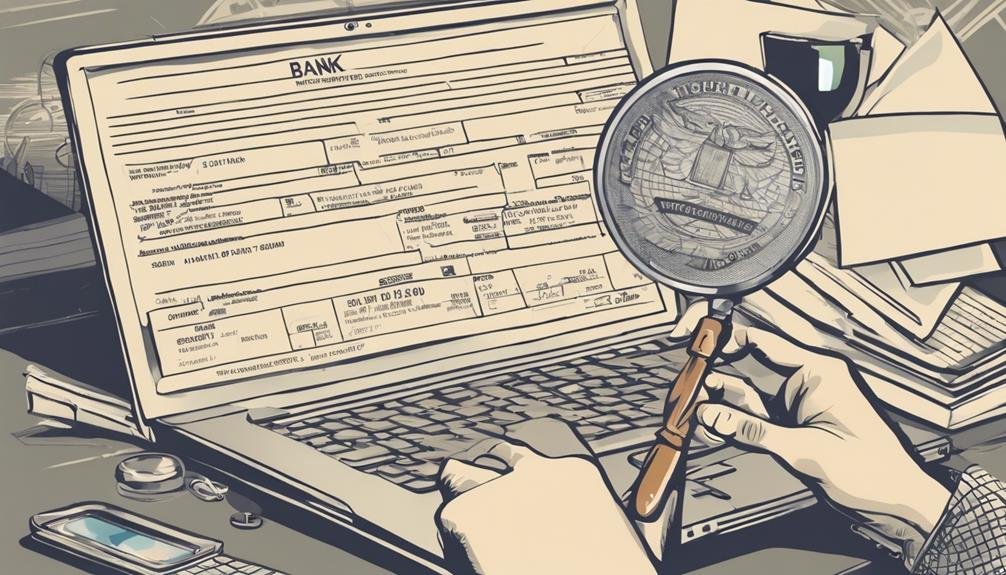Cryptocurrency exchanges combat money laundering with multi-layered strategies. These include robust transaction monitoring systems, blockchain for transparent data, and sophisticated customer due diligence. Identifying high-risk users and enhanced due diligence are critical. Automated identity checks streamline verification processes. Ongoing monitoring guarantees adherence to AML standards.
Effective customer profiling aids in risk detection. Risk rating mechanisms prioritize resources for monitoring. Essential components include tracking suspicious transactions promptly. To learn more about AML KYC compliance strategies for crypto exchanges, explore the detailed implementation of blockchain technology, thorough KYC checks, and essential compliance components for a proactive stance against money laundering.
Table of Contents
Brief Overview of AML KYC Compliance for Crypto Exchanges
- Comprehensive customer due diligence is crucial.
- Utilize blockchain for transparent and secure transactions.
- Implement thorough KYC and CDD checks consistently.
- Verify bank accounts to enhance due diligence.
- Conduct enhanced due diligence for high-risk users.
AML KYC Implementation Strategies
When establishing AML KYC implementation strategies for crypto exchanges, a comprehensive approach to customer due diligence is vital to guarantee regulatory compliance and mitigate money laundering risks effectively. KYC, which stands for Know Your Customer, involves verifying users’ identities and evaluating the level of risk they pose. Enhanced Due Diligence (EDD) is particularly significant for high-risk users in ensuring compliance with AML regulations. Consistent application of customer due diligence and KYC standards across all blockchain services is essential for strong AML and KYC implementation in the crypto space.
Effective customer profiling techniques are pivotal in identifying potential money laundering activities on crypto exchanges. By utilizing blockchain technology, these platforms can enhance their AML and KYC implementation strategies to combat money laundering more effectively. Blockchain technology offers transparency and immutability, making it a valuable tool in guaranteeing compliance with AML regulations and preventing illicit activities within the crypto ecosystem.
Blockchain Technology for AML

Blockchain technology is pivotal in enhancing AML efforts by providing transparency in transaction data. The immutability of blockchain records guarantees that AML data remains secure and tamper-proof. Smart contracts further automate compliance processes, streamlining operations and bolstering the fight against financial crimes in the crypto exchange domain.
Role of Blockchain
Utilizing blockchain technology in anti-money laundering (AML) efforts revolutionizes the transparency and efficiency of monitoring cryptocurrency transactions. Blockchain’s decentralized structure enables the transparent and immutable recording of all transactions, aiding in tracking and analyzing transaction patterns to identify suspicious activities effectively.
Smart contracts, a feature of blockchain technology, can automate compliance processes, enhancing the efficiency of AML procedures for crypto exchanges. The decentralized nature of blockchain reduces the vulnerability to data manipulation, ensuring the integrity of AML processes. Additionally, using immutable cryptographic hashes in blockchain provides secure storage and verification of AML data, which is essential for regulatory audits.
By leveraging these capabilities, blockchain is pivotal in strengthening AML measures within the cryptocurrency ecosystem.
AML Data Transparency
Integrating blockchain technology in anti-money laundering efforts within crypto exchanges greatly enhances data transparency for AML purposes. Using blockchain’s immutable ledger, AML compliance mechanisms in crypto exchanges can effectively track and trace funds to prevent money laundering activities. The decentralized nature of blockchain guarantees that transparency is maintained throughout AML processes, providing regulators and stakeholders with a clear view of transactions.
The presence of immutable records on the blockchain facilitates the swift identification and investigation of suspicious activities in real time. Leveraging blockchain for AML data transparency strengthens the integrity of cryptocurrency transactions. It bolsters the overall security measures within the crypto industry, safeguarding against illicit financial activities.
Thorough KYC and CDD Checks

Executing comprehensive KYC and CDD checks is essential for crypto exchanges to mitigate money laundering risks and ensure regulatory compliance. To guarantee effective AML compliance and prevent illicit activities, exchanges must focus on the following key aspects:
- Verifying customer identities through detailed KYC processes.
- Evaluating the risk associated with each customer through CDD checks.
- Implementing Enhanced Due Diligence (EDD) for higher-risk users.
- Ensuring the consistent application of CDD and KYC standards across all services.
Bank Account Verification for Due Diligence

Implementing bank account verification procedures is an essential aspect of due diligence protocols for identifying high-risk users within crypto exchanges. By verifying a user’s linked bank account details, valuable information can be obtained to confirm their identity and evaluate potential money laundering risks. Consistent application of Customer Due Diligence (CDD) standards, which includes bank account verification, is critical for effective Anti-Money Laundering (AML) compliance in the crypto industry.
Enhanced Due Diligence (EDD) may be required for higher-risk users based on the insights gathered from bank account verification processes. Leveraging blockchain technology for bank account verification can enhance the credibility and security of the due diligence process and streamline the verification procedures on crypto exchanges. By integrating bank account verification into their due diligence frameworks, crypto exchanges can better mitigate money laundering risks and ensure regulatory compliance in their operations.
Enhanced Due Diligence for High-Risk Users

Conducting Enhanced Due Diligence (EDD) is essential when dealing with high-risk users on crypto exchanges to mitigate money laundering risks effectively. EDD involves a comprehensive investigation into the background, financial activities, and the source of funds for these users. Implementing EDD measures is vital when it comes to high-risk users, such as politically exposed persons (PEPs) or individuals with suspicious transaction patterns. By scrutinizing these users more closely, crypto exchanges can better comply with AML regulations and prevent illicit financial activities. Here are key points to keep in mind when conducting Enhanced Due Diligence for high-risk users:
- Perform a detailed background check on the individual.
- Scrutinize the user’s financial activities for any unusual patterns.
- Verify the legitimacy of the user’s source of funds.
- Monitor the user’s transactions regularly for any suspicious behavior.
Consistent CDD and KYC Standards

Consistent CDD and KYC standards in crypto exchanges involve implementing enhanced verification procedures, automated identity checks, and ongoing monitoring systems. These measures are essential for ensuring that users’ personal information is accurately collected, verified, and continuously monitored to mitigate money laundering risks. By maintaining stringent CDD and KYC standards, crypto exchanges can strengthen their AML compliance efforts and uphold regulatory requirements in the industry.
Enhanced Verification Procedures
Maintaining consistency in Customer Due Diligence (CDD) and Know Your Customer (KYC) standards is crucial for ensuring robust AML compliance in the operations of crypto exchanges. Enhanced verification procedures in crypto exchanges encompass various elements such as:
- Gathering users’ names, IDs, residences, registered devices, and primary IP addresses.
- Utilizing bank accounts associated with wallets for customer due diligence.
- Performing Enhanced Due Diligence (EDD) for higher-risk users.
- Implementing effective customer profiling and risk rating strategies.
These measures strengthen AML compliance efforts by establishing a thorough framework to verify users’ identities and evaluate potential risks linked to their transactions. By integrating these enhanced verification procedures, crypto exchanges can improve their compliance with regulatory requirements.
Automated Identity Checks
Ensuring adherence to standardized procedures for customer due diligence and Know Your Customer verification is foundational to crypto exchanges’ robust AML compliance framework. Automated identity checks play an important role in maintaining consistency in verifying user information such as name, ID, address, registered devices, and primary IP address. By implementing cross-platform KYC procedures, exchanges can conduct thorough customer due diligence by linking bank accounts to wallets.
Higher-risk users should undergo Enhanced Due Diligence (EDD) to enhance the AML compliance framework. Effective customer profiling and risk rating based on automated identity checks are vital to preventing money laundering within crypto exchanges. These automated processes streamline compliance efforts and help exchanges stay ahead in the fight against financial crimes.
Ongoing Monitoring Systems
To uphold the integrity of AML compliance frameworks within crypto exchanges, ongoing monitoring systems play a crucial role in ensuring the continual adherence to standardized procedures for Customer Due Diligence (CDD) and Know Your Customer (KYC) verification.
- Ongoing monitoring systems maintain consistent CDD and KYC standards.
- Regular verification of user information includes name, ID, address, registered devices, and primary IP address.
- Linking bank accounts to wallets enables thorough CDD to assess user risk.
- Higher-risk users undergo Enhanced Due Diligence (EDD) procedures for in-depth risk assessment.
Effective Customer Profiling

Effective customer profiling in crypto exchanges involves meticulously gathering detailed information encompassing customers’ identities, transactions, and behavioral patterns. This process plays an important role in the KYC and AML compliance efforts of exchanges, aiding in identifying potential risks and detecting suspicious activities. By analyzing customer data and behavior patterns, exchanges can categorize customers based on their risk levels, enabling the application of appropriate due diligence measures.
Creating thorough customer profiles allows exchanges to strengthen their AML and KYC frameworks, mitigating the risks associated with money laundering and terrorist financing. Leveraging advanced technology and data analytics further enhances customer profiling techniques, facilitating improved risk assessment and regulatory compliance. Through effective customer profiling, crypto exchanges can better safeguard their platforms, protect their users, and uphold the financial system’s integrity by preventing illicit activities and ensuring a secure trading environment.
Risk Rating for AML Compliance

Risk rating plays an important role in crypto exchanges’ anti-money laundering (AML) compliance framework by evaluating the potential for money laundering or terrorist financing activities.
- Assigning risk scores to customers based on transaction behavior, geographic location, and source of funds.
- Categorizing customers into low, medium, or high risk to tailor AML measures accordingly.
- Prioritizing resources for enhanced due diligence on high-risk customers to mitigate financial crime risks.
- Continuous monitoring and updating of risk ratings are essential to adapt to changing customer profiles and evolving money laundering tactics in the crypto industry.
Vital Components for AML in Crypto

Implementing robust transaction monitoring systems is essential for ensuring effective anti-money laundering compliance in the cryptocurrency industry. Cryptocurrency exchanges face significant challenges in preventing money laundering due to virtual currencies’ decentralized and pseudonymous nature. To combat this, stringent AML and KYC compliance measures are indispensable components.
AML programs in crypto must include thorough customer onboarding processes to verify identities and monitor transactions for any suspicious activity. The regulatory landscape surrounding virtual currencies requires financial institutions to report suspicious transactions to comply with AML regulations promptly. Criminals often exploit crypto exchanges for laundering purposes, with substantial amounts estimated to have been laundered through cryptocurrencies since 2016.
Maintaining a proactive stance on identifying and reporting suspicious transactions is essential for crypto exchanges to uphold AML compliance standards and combat money laundering effectively.
Frequently Asked Questions
What Is the KYC AML Policy for Crypto?
Identity verification and customer due diligence are integral components of a KYC AML policy for crypto exchanges. These measures enable risk assessment, compliance monitoring, and transaction monitoring in line with regulatory requirements. Enhanced due diligence further strengthens the exchange’s AML framework.
What Is the KYC Process of Crypto Exchanges?
Initiating on a journey akin to meticulous passport control, the KYC process in crypto exchanges involves identity verification, document submission, customer onboarding, compliance checks, risk assessment, enhanced due diligence, and transaction monitoring for regulatory adherence and security measures.
What Is the AML System for Cryptocurrency?
Cryptocurrency regulations enforce robust Anti Money Laundering (AML) systems to monitor transactions, verify customer identities, and comply with regulatory requirements. Compliance challenges necessitate effective risk mitigation strategies through stringent transaction monitoring to combat financial crimes.
How Blockchain Is Used for KYC AML Compliance?
Blockchain technology revolutionizes KYC/AML compliance by ensuring secure identity verification, automating compliance processes, enabling risk assessment, encrypting data, monitoring transactions, and ensuring regulatory adherence. Its immutable nature and decentralized structure enhance transparency and efficiency.
Conclusion
Implementing robust AML KYC strategies is crucial for crypto exchanges to maintain compliance and mitigate financial risks. By leveraging blockchain technology, conducting thorough KYC and CDD checks, verifying bank accounts, and implementing enhanced due diligence for high-risk users, exchanges can establish consistent standards for AML compliance. Effective customer profiling and risk rating are essential to achieving a secure and compliant environment.
These measures guarantee the integrity of the cryptocurrency market and protect against illicit activities.




